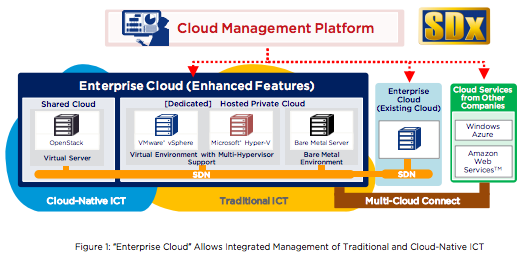5 Trends in Enterprise Cloud Services
Even though the future of IT belongs to the cloud, much of the enterprise world is still clinging to legacy systems. In fact, 90 percent of workloads today are completed outside of the public cloud. With this continued resistance to cloud services adoption at the enterprise level, today’s “cloud evangelists” are playing a more important role in the industry than ever before.
The role of a cloud evangelist sits somewhere between the duties of a product marketer and the company’s direct link to customers. These individuals are responsible for spreading the doctrine of cloud computing and convincing reluctant IT admins to make the jump to the cloud. It’s a dynamic role and nowhere is this more apparent than with the talented cloud evangelists at NTT Communications.
In a recent interview from NTT Communications, two of the company’s leading cloud evangelists, Masayuki Hayashi and Waturu Katsurashima, sat down to chat about the current challenges slowing enterprise cloud migration and what companies can do to help mitigate those challenges. In this post, we take a look at the five areas that are top-of-mind for cloud evangelists today.
The Changing Role of Cloud Evangelists
While the role itself may be new, it is not insulated from change. When it was first established, cloud evangelists were responsible for ferrying customers through every stage of cloud adoption. From preliminary fact finding to architecting the final network, cloud evangelists played a prominent role.
Today, that hands-on approach is quickly changing. As Hayashi states in the article, “Evangelists have traditionally played the “forward” position, but recently we are more like “midfielders” who focus on passing the ball to others.” Rather than managing every task involved, evangelists are placing more focus on improving processes and strengthening organizational knowledge.
Slow Migration of On-Premise Systems to the Cloud
The number of enterprises migrating on-premise datacenters to the cloud has been less than stellar in recent years. Cloud services migrations have remained relatively flat year-over-year largely due to the complexities surrounding migration. Enterprises are having difficulty simultaneously managing both their existing infrastructure and bringing new cloud-based services online.
For evangelists, it’s important to consider this added complexity when proposing a migration plan. NTT Communications Chief Evangelist Wataru Katsurashima recommends finding specific solutions that can accommodate the unique needs of enterprise cloud migration such as hybrid cloud infrastructures that function like a single, public cloud environment.
High Migration Costs are Slowing Adoption
The added complexity of enterprise cloud migration also directly affects the price of migration, increasing it beyond reach of some companies. The expensive price tag is forcing many enterprises to rethink their decision to migrate to the cloud, opting instead to delay the migration another year or executing a much slower, gradual migration.
One discussed solution to this high cost is using existing services within the VMware vCloud® Air™ Network. According to Katsurashima, leveraging technology from NTT communications and VMware in a synergistic way can dramatically cut down costs through efficiencies and better utilization.
New Hybrid Cloud Structures on the Horizon
Like the role of cloud evangelists, the hybrid cloud, too, is changing. Hayashi explains:
“In the past, a hybrid cloud was similar to a Japanese hot spring inn, with a single hallway that leads from the hot spring to each guest room. NTT Communications aims to achieve a “modern hotel” model. In other words, there is one front desk and a variety of rooms with different purposes, such as extended-stay rooms for VIPs and rooms for business meetings.”
The hotel analogy provides us with a way to visualize the new features and capabilities that hybrid cloud environments must deliver. Since no one cloud service provider can be everything, establishing greater levels of collaboration and cross-pollination between service providers is critical to success.
Redefining the Role of Information System Departments
The days of information system departments only responding to the demands of individual business departments are over. The IT teams that do not help business departments innovate from the inside-out will become increasingly obsolete.
This article was provided by our service partner : Vmware





